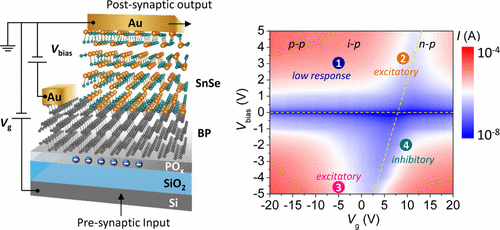Credit: American Chemical Society
One of the greatest challenges facing artificial intelligence development is understanding the human brain and figuring out how to mimic it. Now, one group reports in ACS Nano that they have developed an artificial synapse capable of simulating a fundamental function of our nervous system—the release of inhibitory and stimulatory signals from the same "pre-synaptic" terminal.
The human nervous system is made up of over 100 trillion synapses, structures that allow neurons to pass electrical and chemical signals to one another. In mammals, these synapses can initiate and inhibit biological messages. Many synapses just relay one type of signal, whereas others can convey both types simultaneously or can switch between the two. To develop artificial intelligence systems that better mimic human learning, cognition and image recognition, researchers are imitating synapses in the lab with electronic components. Most current artificial synapses, however, are only capable of delivering one type of signal. So, Han Wang, Jing Guo and colleagues sought to create an artificial synapse that can reconfigurably send stimulatory and inhibitory signals.
The researchers developed a synaptic device that can reconfigure itself based on voltages applied at the input terminal of the device. A junction made of black phosphorus and tin selenide enables switching between the excitatory and inhibitory signals. This new device is flexible and versatile, which is highly desirable in artificial neural networks. In addition, the artificial synapses may simplify the design and functions of nervous system simulations.
More information: "Emulating Bilingual Synaptic Response Using a Junction-Based Artificial Synaptic Device" ACS Nano (2017). pubs.acs.org/doi/abs/10.1021/acsnano.7b03033
Abstract
Excitatory and inhibitory postsynaptic potentials are the two fundamental categories of synaptic responses underlying the diverse functionalities of the mammalian nervous system. Recent advances in neuroscience have revealed the co-release of both glutamate and GABA neurotransmitters from a single axon terminal in neurons at the ventral tegmental area that can result in the reconfiguration of the postsynaptic potentials between excitatory and inhibitory effects. The ability to mimic such features of the biological synapses in semiconductor devices, which is lacking in the conventional field effect transistor-type and memristor-type artificial synaptic devices, can enhance the functionalities and versatility of neuromorphic electronic systems in performing tasks such as image recognition, learning, and cognition. Here, we demonstrate an artificial synaptic device concept, an ambipolar junction synaptic devices, which utilizes the tunable electronic properties of the heterojunction between two layered semiconductor materials black phosphorus and tin selenide to mimic the different states of the synaptic connection and, hence, realize the dynamic reconfigurability between excitatory and inhibitory postsynaptic effects. The resulting device relies only on the electrical biases at either the presynaptic or the postsynaptic terminal to facilitate such dynamic reconfigurability. It is distinctively different from the conventional heterosynaptic device in terms of both its operational characteristics and biological equivalence. Key properties of the synapses such as potentiation and depression and spike-timing-dependent plasticity are mimicked in the device for both the excitatory and inhibitory response modes. The device offers reconfiguration properties with the potential to enable useful functionalities in hardware-based artificial neural network.
Journal information: ACS Nano
Provided by American Chemical Society
























